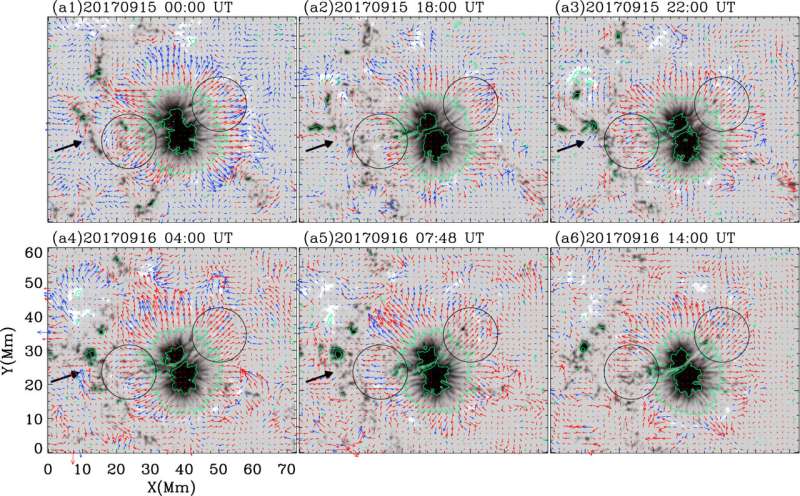Researchers find potential mechanism of solar light bridge formation and penumbra disappearance

Sunspots are the most noticeable manifestation of solar magnetic field concentrations in the photosphere. A typical mature sunspot has an umbra and a penumbra. Light bridges (LBs) are the strip-like bright features, two ends of which connect the penumbra and span the umbra of a sunspot.
Commonly, the appearance of light bridges is an indication of sunspot decay or fragmentation. The evolution of sunspots is closely related to solar eruptions, e.g., solar flares, coronal mass ejections, and filament eruptions. However, up to now, the formation and decay mechanisms of sunspots were poorly understood.
Researchers led by Prof. Yan Xiaoli from Yunnan Observatories of the Chinese Academy of Sciences (CAS) and Li Qiaoling from Yunnan University analyzed the decay process of a sunspot in active region NOAA 12680 on the sun by using the stray light calibrated data from the Solar Dynamics Observatory/Helioseismic and Magnetic Imaging (SDO/HMI), and discussed the influence of the light bridge on a decaying sunspot.
The results were published in The Astrophysical Journal on Jan. 11.
The researchers found that at the beginning of sunspot decay, some elongated dark structures were gradually separated from the umbra. The intensity, vertical field strength and magnetic inclination of these dark structures were between those of the umbra and penumbra. With the formation of a light bridge, the total magnetic flux of the whole penumbra region gradually decreased, and part of the penumbra located on one side of the light bridge rapidly disappeared.
In addition, after the appearance of an outward motion of magnetic flux along the light bridge, the decay rate of the area and magnetic flux of the penumbral sector rapidly deceased. These results suggested that the rapid decay of the penumbral sector was correlated with the light bridge.
“The dark structure in the penumbra and the formation of light bridge may be the result of magnetic flux spreading out from the umbra, which may accelerate the decay of the sunspot,” said Prof. Yan.
More information:
Qiaoling Li et al, Rapid Decay of a Penumbral Sector Associated with a Strong Light Bridge in Active Region NOAA 12680, The Astrophysical Journal (2023). DOI: 10.3847/1538-4357/aca667
Citation:
Researchers find potential mechanism of solar light bridge formation and penumbra disappearance (2023, January 18)
retrieved 18 January 2023
from https://phys.org/news/2023-01-potential-mechanism-solar-bridge-formation.html
This document is subject to copyright. Apart from any fair dealing for the purpose of private study or research, no
part may be reproduced without the written permission. The content is provided for information purposes only.
For all the latest Science News Click Here
For the latest news and updates, follow us on Google News.

